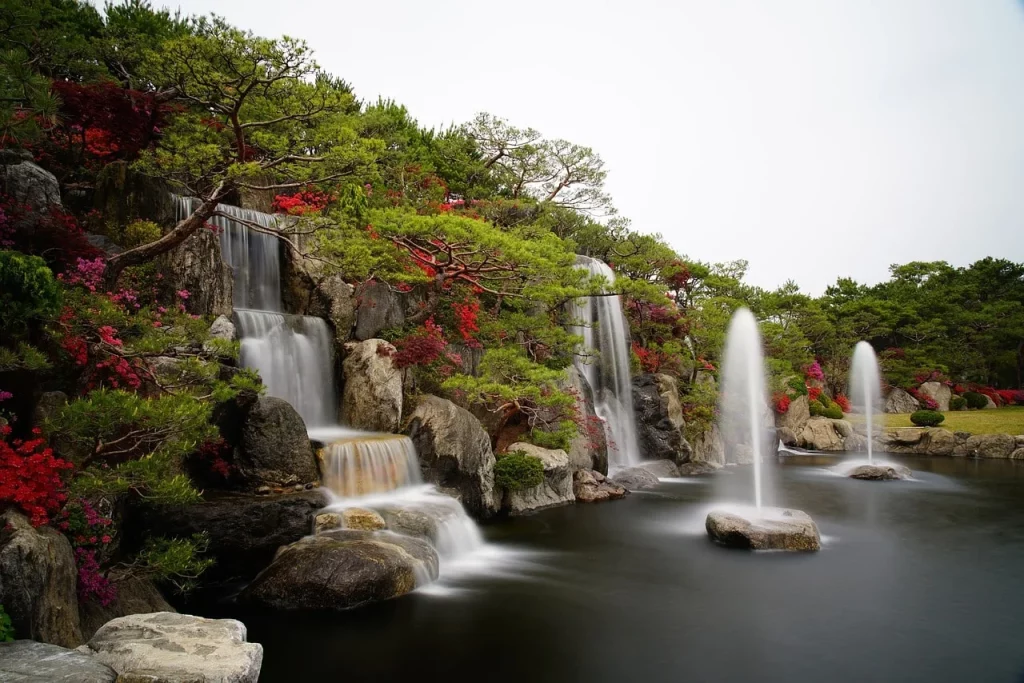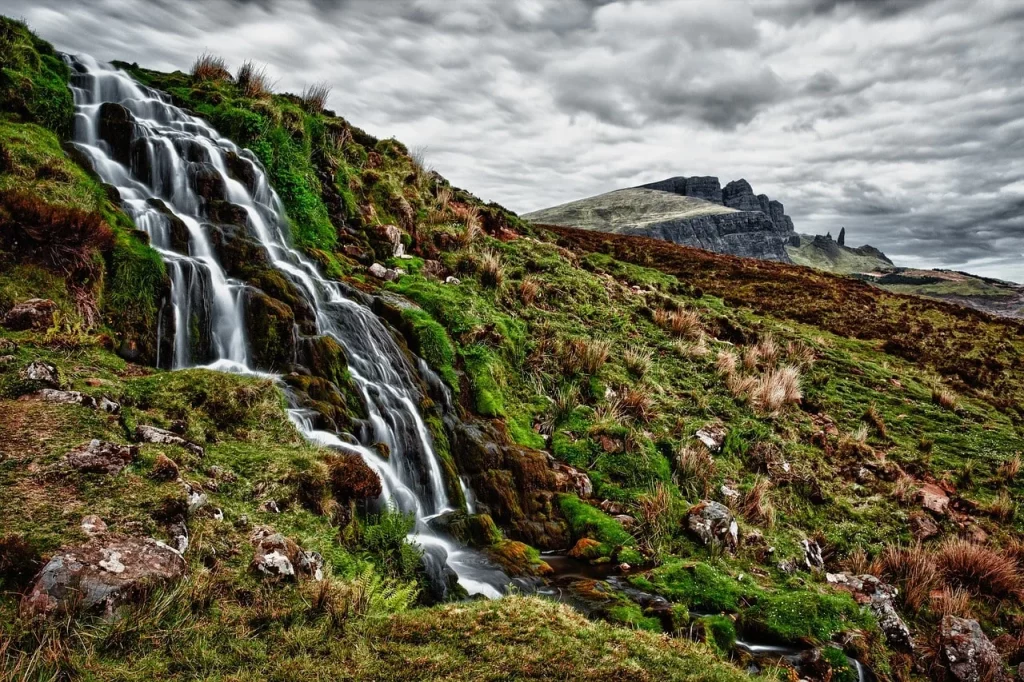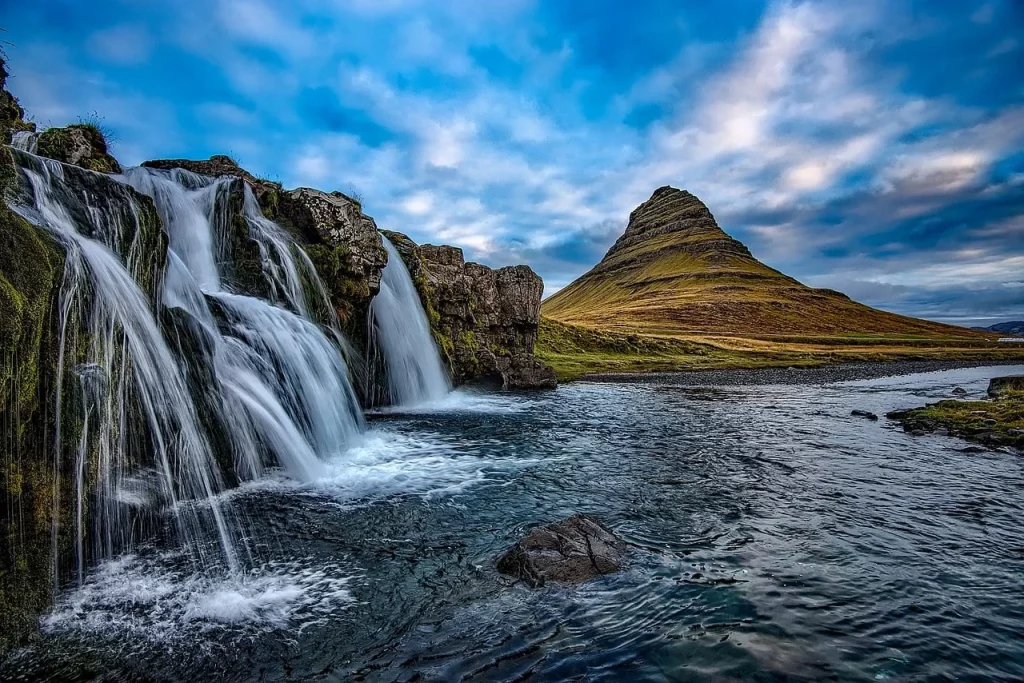Did you know that every waterfall has its own unique story? We’re set to uncover these stories, one fact at a time. These cascading wonders are more than just a feast for the eyes; they’re a testament to the relentless force and beauty of nature.
As we delve into their hidden mysteries, from the ways they’re formed to the ecosystems they sustain, we’ll also discover their impact on human culture and history. Prepare to be enthralled as we reveal what makes waterfalls among the planet’s most spectacular and beloved natural phenomena.
There is a hidden message in every waterfall. It says, if you are flexible, falling will not hurt you.
Mehmet Murat Ildan
Waterfall Facts
Before we start our journey, remember this: a quiz awaits at the end of this article. Pay close attention to each detail and prove your mastery of these natural wonders.
- Angel Falls in Venezuela is the world’s tallest waterfall, plunging an astonishing 3,212 feet.
- Waterfalls can form through various processes, including erosion, earthquakes, and glacial melt.
- The term “waterfall” comes from the Old English word wætergefeall, which means “a cascade of water.”
- Niagara Falls, a world-renowned waterfall, can discharge over six million cubic feet of water per minute at its peak flow.
- Waterfalls play a crucial role in oxygenating the water, benefiting aquatic life.
- Yosemite Falls in California is one of the highest waterfalls in the United States, with a total drop of 2,425 feet.
- Plunge waterfalls, like Angel Falls, drop vertically, losing contact with the bedrock.
- Some waterfalls, known as tidal waterfalls, are influenced by ocean tides.
- Victoria Falls on the Zambezi River is one of the largest waterfalls in the world, measuring about a mile in width.
- A waterfall’s roar can be heard from miles away, depending on its size and the surrounding terrain.
- Horsetail falls maintain some contact with the rock behind them as they fall.
- Frozen waterfalls, seen in colder climates, create stunning ice formations during winter.
- Underwater waterfalls exist, like the one in the Denmark Strait, where colder, denser water falls below warmer water.

- The speed of the falling water in a waterfall can be influenced by the volume of water and the height of the drop.
- Iguazu Falls, located on the border of Argentina and Brazil, consists of approximately 275 individual drops.
- Block waterfalls descend from a wide river or stream, forming a uniform front.
- Waterfalls often form in areas of harder rock that are more resistant to erosion.
- Some waterfalls, like seasonal ones, may completely dry up during certain times of the year.
- Cascade waterfalls tumble down over rocks in a series of small drops or steps.
- Limestone and basalt are common rock types around which waterfalls form due to their resistance to erosion.
- Ribbon waterfalls are characterized by their narrow streams and greater height than width.
- Sediment carried by water can carve and shape the waterfall’s plunge pool.
- Waterfalls can significantly contribute to the local microclimate, often creating a cooler and more humid environment.
- Artificial waterfalls, found in gardens and parks, are created for aesthetic and recreational purposes.
- Some ancient cultures worshipped waterfalls, viewing them as sacred places.
- Water from waterfalls is often used in hydroelectric power generation.
- Fan waterfalls spread horizontally as they descend while maintaining contact with the bedrock.
- Tourism around major waterfalls contributes significantly to local economies.

- Waterfalls can create natural pools at their base, making them popular for swimming and recreation.
- Erosion at the base of a waterfall can lead to the creation of a plunge pool.
- The rate of erosion at the base of a waterfall can lead to its migration upstream over time.
- Water vapor from waterfalls can support unique plant and moss species in the surrounding area.
- Mist from waterfalls can be seen from a distance, often creating rainbows in sunny conditions.
- Cataract is another term used for a large, powerful waterfall.
- The height of a waterfall is measured from its highest point of water flow to the lowest point of its plunge pool.
- Some waterfalls feature a series of drops, known as multi-step waterfalls.
- Waterfalls have been featured prominently in art and literature, symbolizing both beauty and power.
- Geological uplift can create the necessary conditions for waterfall formation.

- Veiling waterfalls feature a thin sheet of water that descends over a broad area.
- Rain and melting snow can significantly increase the flow and size of waterfalls.
- Many waterfalls are inaccessible or hidden, remaining unexplored and unnamed.
- Some of the world’s tallest waterfalls are found in remote, uninhabited regions.
- Waterfall ice climbing is a popular, though risky, winter sport in some regions.
- A waterfall’s ecosystem can include unique species of fish that have adapted to its turbulent environment.
- Waterfalls often act as natural barriers for aquatic species, leading to diverse evolutionary paths in isolated ecosystems.
- Cultural legends and myths often surround famous waterfalls, adding to their mystique.
- The sound of waterfalls has been used in sound therapy for its calming effects.
- Some waterfalls can be seen flowing upwards, an optical illusion caused by strong winds.
- Submarine waterfalls are larger and more powerful than those on land, formed by differences in water density in the ocean.
- Kaieteur Falls in Guyana is one of the world’s most powerful waterfalls by volume, combining great height and a large water flow.
Waterfall Myths

Having explored all these fun facts about waterfalls, we now move on to the next section. Let’s separate what’s true and what’s not.
- Waterfalls Never Change Their Appearance
Contrary to popular belief, waterfalls are not static features. Over time, erosion, seasonal changes, and varying water levels can significantly alter their appearance. It’s fascinating how the force of water can sculpt and reshape the surrounding landscape, gradually transforming the waterfall’s character. - The Tallest Waterfalls Are the Most Powerful
The height of a waterfall doesn’t necessarily equate to its power. The volume of water and the steepness of the fall are key factors in determining its force. Some shorter waterfalls, due to their massive water flow, can be much more powerful than taller, slender ones. - All Waterfalls Are Natural
While many are natural, others are man-made. These artificial waterfalls are created for aesthetic purposes in gardens and parks or for practical uses in dams and water management systems. - Waterfalls Are Only Found in Remote Areas
It’s a common misconception that waterfalls are exclusively located in remote or wilderness areas. In reality, several waterfalls are found near urban centers or are easily accessible by roads. This accessibility allows more people to enjoy the beauty and splendor of these natural phenomena. - Waterfalls Flow Continuously Throughout the Year
The flow of many waterfalls is not constant and can vary greatly with the seasons. Some may even dry up during periods of drought. The seasonal variation in water flow adds a dynamic element to waterfalls, with each season potentially offering a unique viewing experience.
No products found.
Waterfall Quotes

I hope you are enjoying our journey so far. We now move on to the quotes section. Below you will find my list of favorite quotes about waterfalls. Let me know yours in the comments so I can add them to the list.
Water is the driving force of all nature.
Leonardo da Vinci
Leonardo da Vinci, the renowned Italian polymath of the Renaissance era, reflects on the fundamental and powerful role of water in the natural world, including the creation of waterfalls.
Experiencing the present purely is being empty and hollow; you catch grace as a man fills his cup under a waterfall.
Annie Dillard
Annie Dillard, an American author known for her narrative prose in both fiction and non-fiction, uses the imagery of a waterfall to describe the experience of living in the moment as one of receiving grace and fullness.
Look with open eyes and you will see the beauty of the waterfall.
Anthony Hincks
Anthony Hincks, an author known for his inspirational writings, encourages a perspective of mindfulness and awareness to appreciate the beauty in natural phenomena like waterfalls.
A waterfall cannot be silent, just as the wisdom! When they speak, the voice of power speaks!
Mehmet Murat Ildan
Mehmet Murat Ildan, in this quote, draws a parallel between the powerful and unmistakable sound of a waterfall and the influential voice of wisdom.
Do not seek water, get thirst.
Rumi
Rumi, the 13th-century Persian poet and Sufi mystic, uses a paradoxical statement to imply that the true longing or desire (thirst) brings one closer to the fulfillment or realization (water), akin to the journey one might take to find a waterfall.
Waterfall FAQ

You’ve traveled through the beauty of waterfalls in words; now steady your focus for the FAQs. This section is key to mastering the quiz that follows. Read carefully, and don’t disappoint me.
- Which waterfall is the highest in the world?
Angel Falls in Venezuela holds the title of the highest waterfall in the world. This breathtaking natural wonder drops an astonishing 979 meters (3,212 feet) from a tabletop mountain called Auyán-tepui. What makes it even more spectacular is that the water plummets over the edge uninterrupted for most of this distance, making it a truly magnificent sight. - Can waterfalls freeze?
Yes, waterfalls can freeze, though it’s a rare and mesmerizing phenomenon. It usually occurs in regions that experience extremely cold temperatures. When the temperature drops significantly, the moving water starts to freeze, forming a captivating structure of ice. - How do waterfalls affect the environment?
They contribute significantly to their environment by creating unique ecosystems. The constant motion of water aerates the water, increasing oxygen levels which benefits both plant and aquatic life. Additionally, waterfalls can lead to the formation of mist and spray zones, supporting a variety of moisture-loving plants and animals. They also contribute to erosion and the shaping of the landscape over time. - What is the largest waterfall system in the world?
The largest waterfall system in the world is the Iguazu Falls, located on the border of Brazil and Argentina. This colossal and stunningly beautiful system consists of approximately 275 individual waterfalls and cascades. The sheer scale and volume of water passing over these falls make them one of the most impressive natural spectacles on the planet. - Why do some waterfalls dry up?
They may dry up for several reasons. The most common is a change in the water source feeding the waterfall, such as a decrease in rainfall or changes in upstream water usage, like damming or irrigation. Seasonal changes can also affect water flow, with some waterfalls only flowing during specific times of the year, like during snowmelt or rainy seasons.
No products found.
Waterfall Quiz

Welcome to our splash-tastic waterfall quiz! Be warned: if you don’t get any answers right, you might find yourself mysteriously teleported to the top of a waterfall – without a barrel!
Conclusion
In conclusion, waterfalls stand as nature’s grand orchestra, playing a symphony of sounds that can soothe the soul and awaken the spirit. Their thunderous roars and gentle whispers serve as a reminder of the dynamic and ever-changing planet we call home.
As we bid farewell to these magnificent natural wonders, let’s carry their lessons in our hearts, remembering that, like waterfalls, we too possess the power to overcome obstacles and carve our own paths. And for our funny question: Imagine if waterfalls could compete in a ‘who’s the loudest’ contest; which one do you think would take the crown? Let me know in the comments.
2 Sources Used For This ArticleWaterfall Quotes to Inspire – The Solo Globe Trotter


